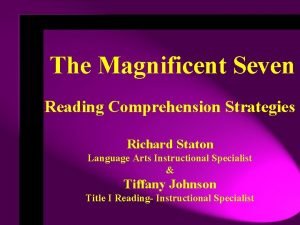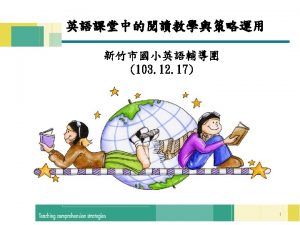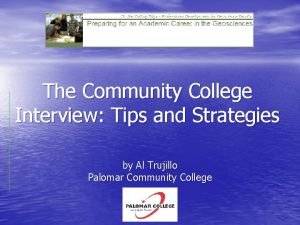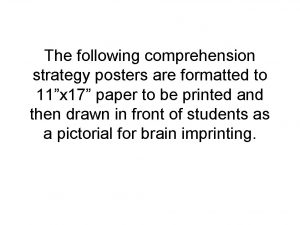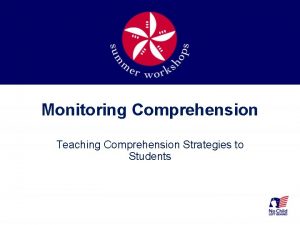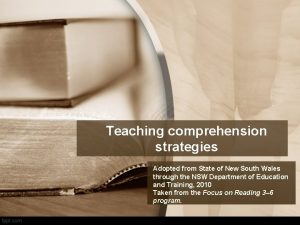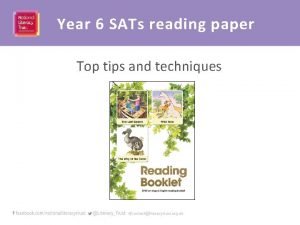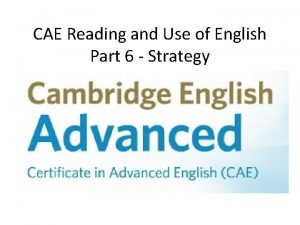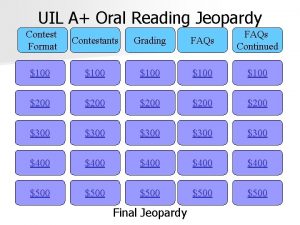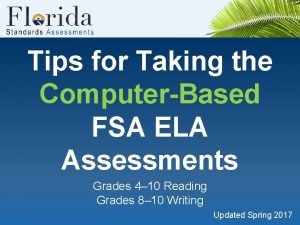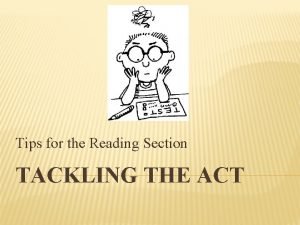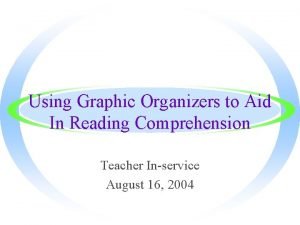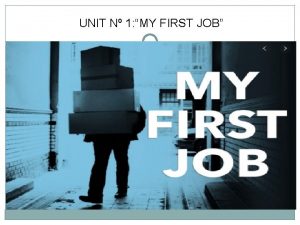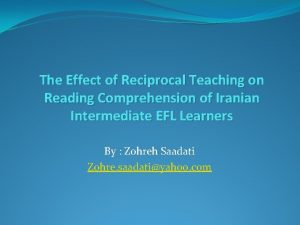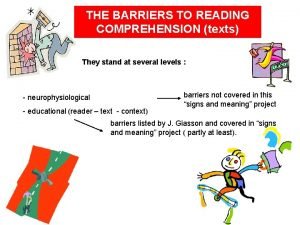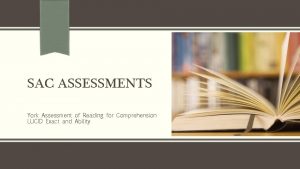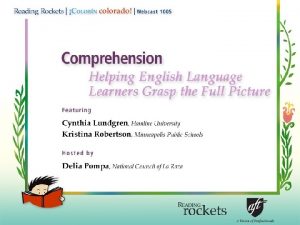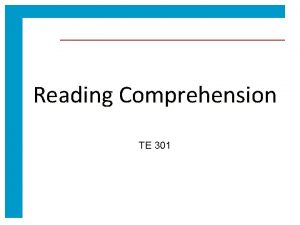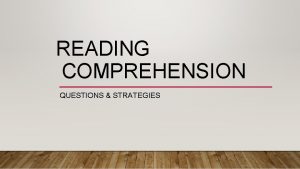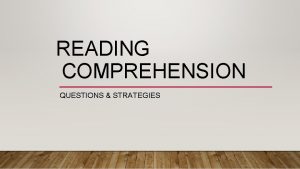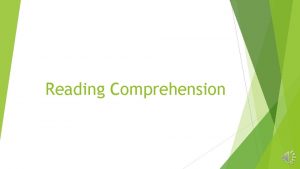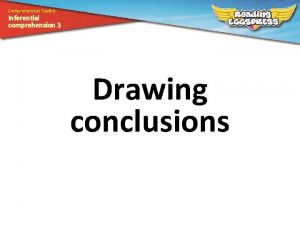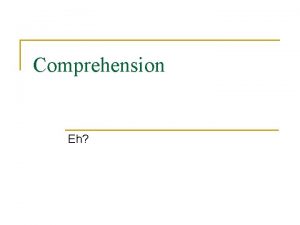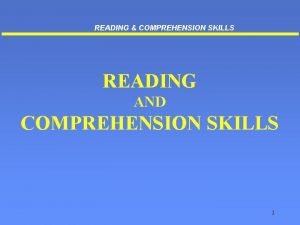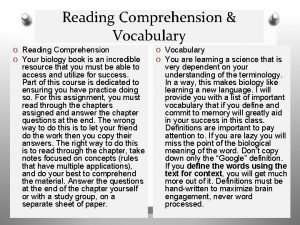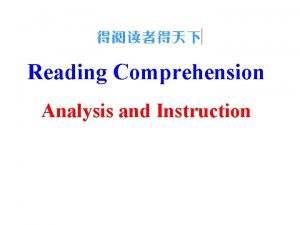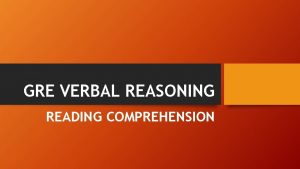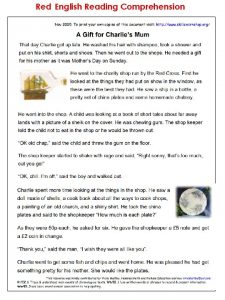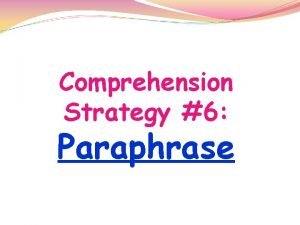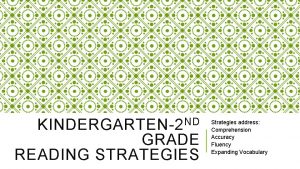Reading Comprehension Strategies Tips for Reading Tests v





















- Slides: 21

Reading Comprehension Strategies . .

Tips for Reading Tests v Read the questions first. v Read the entire passage. v Learn the question types. v Base your answers on information from the passage. A reading test is used to find out how well you read. It is not used to find out how much you already know about the reading topic. Use only information from the reading passage. v Read the questions carefully.

Identify clue words in the questions. As you read each question, identify important words that will help you find the answer in the passage. We call these key words Answer every question, even if you have to guess. Before guessing, cross out any choices that seem wrong. Be a good detective always look back in the reading. Relax!

Types of Questions �Main Ideas �Supporting Details �Sequence �Cause and Effect �Vocabulary �Inference and Prediction �Author’s Purpose

Main Ideas Ø Key words for main idea questions: main idea, subject, theme, lesson, as a whole, in general, mostly, or for the most part. Ø Summarize the passage as you read. Ø Rule out obviously wrong answers. Choose the best one from those that are left. Ø Make sure the answer you choose talks about the whole selection or passage, not just with part of it. Ø Make sure your answer is not only true, but also that it is about the most important idea of the whole selection.

Theme v The theme is really “bigger” more universal, than the main idea. Sometimes it can be described as a study of such topics as strength, courage, family, love, health, happiness, friendship, and so on. Usually theme can be explained as the author’s message or the lesson that the author wants the reader to learn. Theme is seldom mentioned directly. You have to figure it out on your own. The theme connects the passage to all people.

Ø Some of the ways main idea questions are asked: * What is the main idea? * What is theme? * What is another title for the selection? * What lesson is being taught? * What is the selection mostly about?

Supporting Details Ø Scan the passage for key word or phrase. Then read closely to find the answer. Ø Use your finger, an index card, or a ruler to keep our place as you scan the page. Ø Rule out obviously wrong answers. Then choose the best answer from those that are left.

Sequence Ø Sequence of events will usually be told in order in the selection. (NOTALWAYS) Ø Look for key words: first, next, then later, before, after, last, and finally. Look in passage and in the questions. Ø Look for dates and times in a passage.

Cause and Effect �Look for key words, such as cause, because, effect, why, reason, therefore, as a result, due to, factors, responsible, contribute, and produce. �Remember that one event can follow another without being caused by it. Remember something is a cause only if it makes something else happen. �Ask yourself whether one causes the other or whether they simply occur at the same time as one another. �Put the problem and its cause into a “because” sentence.

Vocabulary Ø Keep a vocabulary journal. Write down unfamiliar words ( with definitions). Review! Ø Find the vocabulary word in the passage. Ø Use context clues to find clues to word meanings. Ø Look for key words: also and as (show words are alike). Ø Use suffixes and prefixes to determine meaning.

Look for key words: but, rather, on the other hand (show words with opposite meanings) Ø Plug in answer choices in place of unknown word. Ø Look out for words with more than one meaning. Ø

Inference and Prediction Ø Inferences are guesses based on known facts. You are forming a conclusion about what you read. Ø Base your inferences and predictions on facts from the passage and from your own knowledge. Ø Use your knowledge of cause and effect, along with an understanding of the chronology of events to make inferences. Ø Rule out wrong answers. Then reason to find the BEST one left. Ø You can make inferences in two ways: 1. Reason from a general statement in the passage. 2. Reason from specific facts to a general rule – make a conclusion.

Biography, Nonfiction, and Autobiography �Biography tells a true story about a persons life. �Autobiography tells a true story about the person who is writing the story. �Biographies use words like he and she; autobiographies use words like I and me. �Journals and diaries are types of autobiographies.

Author’s Purpose �As you read ask yourself why did the writer write this? Authors write for many reasons. �Inform – to teach or give the reader information. �Describe – author is giving the reader a description of a person, place, thing, or idea. �Entertain – author write to entertain us. Examples: fantasy, mystery, adventure, science fiction. Reading for fun. �Persuade – author wants you to agree with them. Filled with the authors opinion. �Pay attention to the author’s attitude.

Words to Know �Alliteration – using two or more words beginning with the same consonant sound. Ex. Jolly Jumper �Assonance – a repetition of a vowel sound. Ex. The fat cat from Batsville sat on the mat. �Hyperbole – an exaggeration ex. I walked a million miles. �Metaphor – comparison of two things by describing one in terms of another. �Simile – the comparison of two things using the words like or as. Ex. The book is as tall as a giraffe.

�Personification – giving and object or animal human characteristic. The moon was smiling down on us. �Free verse – a type of poetry that has no standard pattern of rhyme or rhythm. �Atlas – is a book of maps �Almanac – is a book that contains facts about all kinds of topics. It is published every year. �Thesaurus – gives lists of words with similar meanings. �Brochure – a very short booklet that tells about only one topic.

�Table of contents – an outline of the book, found in the front of the book. Tells reader where to find main subjects that are covered in the book. �Glossary – an alphabetical listing that defines important words used in the book.

Fact and Opinion �Fact statements can be proven. �Opinion statements cannot be proven, and use words such as beautiful, ugly, yucky, boring, expensive etc.

Genre � Fiction – tells a made-up story. �Historical fiction – tells about real people and / or real events but uses made up characters, scenes, etc. �Nonfiction – gives true information about real people, places, things, ideas, and events. �Drama – literature written to be spoken and performed on stage. �Poetry – written usually in groups of lines called verses.

Material Taken From: Buckle Down Florida FCAT 2 nd Edition Aim Higher Reading Comprehension Blast Off! FCAT 5 on Florida Reading
 Seven reading strategies
Seven reading strategies Super six
Super six Ace different tests iq tests but
Ace different tests iq tests but College interview tips and strategies
College interview tips and strategies Comprehension strategies posters
Comprehension strategies posters Drta reading strategy
Drta reading strategy Super six comprehension strategies nsw det
Super six comprehension strategies nsw det Sats revision tips
Sats revision tips Cae reading and use of english part 6
Cae reading and use of english part 6 Oral reading uil
Oral reading uil Biology sol practice test
Biology sol practice test Tips for fsa reading
Tips for fsa reading Reading act tips
Reading act tips Pre reading while reading and post reading activities
Pre reading while reading and post reading activities Reading comprehension about inventions
Reading comprehension about inventions Story maps for reading comprehension
Story maps for reading comprehension My first job reading comprehension
My first job reading comprehension Reading comprehension jobs and professions
Reading comprehension jobs and professions Reading comprehension meaning
Reading comprehension meaning Barriers to reading comprehension
Barriers to reading comprehension York assessment of reading for comprehension
York assessment of reading for comprehension Meaning of reading comprehension
Meaning of reading comprehension
